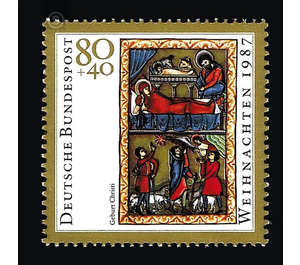Christmas - Germany / Federal Republic of Germany 1987 - 80 Pfennig
| Country | Germany / Federal Republic of Germany |
| Issue Date | 1987 |
| Face Value | 80.00 |
| Color | multi-colored brown |
| Perforation | K 13 3/4 |
| Printing Type | Six-color offset printing |
| Stamp Type | Postage stamp |
| Item Type | Stamp |
| Chronological Issue Number | 1219 |
| Chronological Chapter | GER-BRD |
| SID | 82118 |
| In 38 Wishlists | |
The scenes of the Nativity and the Annunciation to the shepherds are taken from a Psalter, which originated in England at the beginning of the 13th century. England played a decisive role in the development of splendid psalteries with their rich pictorial equipment. During the 12th and early 13th centuries, the Psalter had become the most popular private devotional book of high-ranking circles of the Church and the nobility, and it was only replaced by the Book of Hours in the later Middle Ages. His popularity is reflected above all in his artistic design. The book painters developed an imaginative program. The first step was to mark the groups of psalms that were prayed for morning and evening praise with initials. They reveal a hierarchical structure, from simple feathered ornamentation to lavish tendril work executed with gold and opaque colors and figurative scenes (historicized initials). Soon it became fashionable to put also full-page miniatures at the beginning of the Psalter text, before or after the calendar. Their number varied between three to four and a whole series of 20 or more. The highlight of this development is the Munich Psalter, content of these images are events from the Old and New Testament. Apart from David, who is considered the poet of the Psalms, the pictures have no direct relation to the statement of the Psalms. Rather, they give rise to a kind of edifying picture book, a biblical story in pictures, which enjoyed great popularity with both lay and clerics. A number of monastic workshops specialized in the production of psalteries, and certainly economic considerations played a certain role, although we know very little about how such a commission came about in the thirteenth century. The English Psalter, which the Bavarian State Library preserves among its treasures, is unsurpassed in the richness of its image design. During the reign of Elector Maximilian I of Bavaria (1573 - 1651) he came into the possession of the court library. Further details are unknown. Also about its origin, there are only assumptions on the part of art historians. The calendar indicates by some special entries on the Benedictine abbey Gloucester; the litany, on the other hand, has features that point to Augustinian origin. On the other hand, a whole group of related psalteries seems to have come from Oxford. So it seems reasonable to suppose that the client was someone who had connections to both Gloucester and Augustinians. Was it a lady? The unusually high number of miniatures that speak of the lives of heroic women of the Old Testament (Ruth, Judith, Esther) and the occasional use of feminine grammatical forms in the prayers that follow the litanies allow such an inference. The manuscript has the most distinctive picture cycle from the Old and New Testaments in the 13th century. 90 picture pages, usually with two or more scenes on one side, are added to the psalm text like a kind of picture Bible. It is divided into five sections: before Psalm 1, the largest group of 46 full-page miniatures, after Psalm 51, before Psalm 101, 109 and at the beginning of the Biblical Canica. The calendar, which precedes the psalms, shows medallions in which the monthly works and zodiac signs can be seen. According to the liturgical ten-parting of the Psalter, at the beginning of each section are historicized and large ornamental initials. Three book artists have essentially contributed to the design of the book, as can be seen from certain style differences. The painters may have had older image cycles from which they chose and redesigned in the style of their time. This is how one of the most important picture cycles in medieval English art came about. (Text: Bayerische Staatsbibliothek Munich - Dr. Hermann Hauke)


